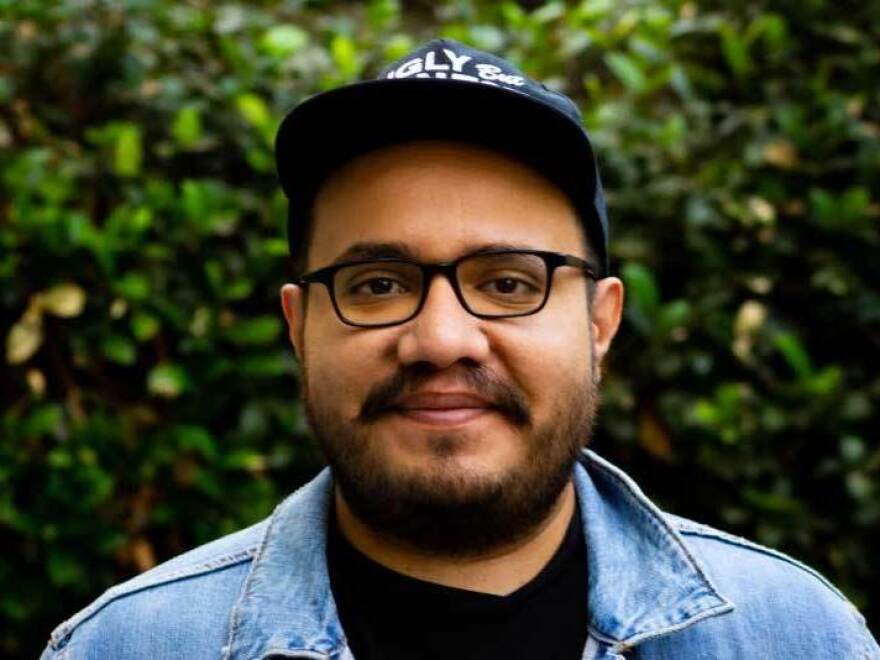Updated January 10, 2022 at 7:55 PM ET
Henry Barajas laughs when he describes how he pitched his recent Latinx fantasy book, Helm Greycastle.
"What if Mordor had a southside?" Barajas says. "What if the world of The Lord of the Rings had a southside?"
The 32-year-old graphic novelist imagined a world where the Aztec Empire still stands and a group of misfit comrades come to the rescue of the last dragon prince.
In Helm Greycastle, Barajas wanted to depict characters he never really saw in the The Lord of the Rings or the game Dungeons and Dragons, some of his favorites growing up.

"I wanted to create something that challenged the Eurocentric fantasy genre while making it organic — and also incorporating Mesoamerican history," he says.
Growing up near the border between the United States and Mexico, Barajas says he "had no idea about Mesoamerican history and was not taught that."
Now, he's trying to bring that history to his books.
Barajas lives in Los Angeles now, but his roots run deep in Tucson, Arizona. That's where he fell in love with comic books.
His family would watch Antiques Roadshow on PBS and see comic books sold for thousands of dollars. That led them to buy boxes of comics, thinking they would find something worth selling. Most of the time, they weren't worth much. But he did gain something else.
"That's how I got a lot of my morals," he says. He read about racism and crowded prisons in Spider-Man, mental health in Batman and feminism in Wonder Woman. "Things that weren't in my regular studies as a child," he remembers.
By the time Barajas was 17, he was working as a bill collector to help his family. During and after work, he spent his time learning everything he could about comics.
By 23, he was working as a journalist at Arizona Daily Star. A few years later, he got the idea for his first big book.
"Growing up, my family would always tell me my great-grandfather did something amazing. But they really didn't go into detail [about] what that was," he says.

Barajas dug into his family history and found that his great-grandfather, Ramon Jaurigue, co-founded the organization Mexican American Yaqui and Others (M.A.Y.O.) in Tuscon, Arizona.
During the 1970s, the group pushed the Tucson City Council to improve conditions for members of the local Pascua Yaqui tribe – a group that's lived in the region for hundreds of years. Barajas says in 1978, his great-grandfather helped the tribe gain federal recognition.
"It's not an everyday thing where you can tell people that your great-grandfather helped one of the last Native American tribes gain federal recognition," he says.
All of this is chronicled in Barajas' 2019 graphic novel La Voz De M.A.Y.O.: Tata Rambo – which is all about the efforts of his great grandfather, who was nicknamed Tata Rambo.
Barajas says he feels proud to share his family history.
"It was really important for me to tell a story that was positive about the indigenous and migrant communities here in Tucson [and] in this country — and to shine a light on not only a civil rights activist, but a World War II veteran," he says.

The graphic novel is now read by college students, sits in libraries and the Smithsonian gift shop and has earned Barajas spots to speak at comic conventions around the country. Now, he's giving advice to younger writers.
"It's all about just being a good person and telling your story," Barajas told guests at the San Diego Comic-Con in late November. "People want to hear your story."
J. Gonzo, the illustrator of the book, still can't believe the success of it.
"It seems surreal," he says. "I can't get my head around it yet."
After years of trying to find his way as a writer, Barajas says he finally found his voice.
"I'm very lucky that people are paying attention and I get to use my comics to tell stories that I feel are important," Barajas says.
He recently worked on an Avengers comic for the city of New York, which encouraged young kids to get vaccinated. Now, he's working on a short project for DC Comics – showing others like him they can be superheroes too.
Copyright 2022 NPR. To see more, visit https://www.npr.org.




